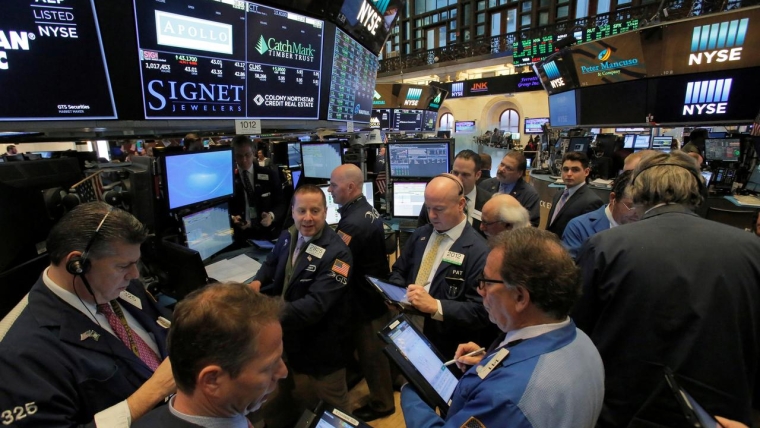
The week has begun with a mild risk-on tone, with US equities showing modest gains and the VIX index continuing to trend lower, down to a fresh two-month low, while global rates are higher. Currency markets have bucked the trend, with the USD outperforming, taking the NZD back well below 0.61. Oil prices are weaker despite some surprise production cuts announced.
US equities began on a weak note and were down as much as 0.9% near the open, but the S&P500 has since recovered, although as we go to print it is only just in positive territory. The NASDAQ index shows more convincing gains, up around 1%. The VIX index continues to trend lower, now down to around 27.
In COVID-19 news, Russia has become the new epicentre of new cases in Europe, while the spread of the virus slows across much of the rest of Europe. Some additional European countries are loosening restrictions, including France, Switzerland and Greece, while the UK is planning a staged easing for the lockdown. New York’s Governor said that certain businesses including construction, curb-side retail, drive-in movie theatres and some recreational activities will reopen from Friday on a regional basis, while NYC’s mayor said that the lockdown is likely to extend into June.
NZ’s PM announced yesterday that NZ would be moving to alert level 2, with shops, restaurants, cinemas and gyms allowed to open from Thursday, schools from Monday and bars from Thursday next week. On RBNZ estimates, this takes the hit to GDP relative to no-restrictions from 19% lower under level 3 to 9% lower under level 2. The ANZ business outlook survey showed rising business confidence and forward looking activity indicators, as businesses anticipated the easing of restrictions. Moving down the alert levels is cause for hope, but we caution that there is a very long way to go yet. Partial indicators are now starting to reveal the full impact of the economic slowdown – card spending fell 47% m/m in April – and we fear that even a move to Level 2 will not provide the boost the economy so badly needs.
NZ rates barely rose yesterday, despite the Friday night sell-off in US Treasuries and the upward pressure in Australian bond yields. This reflects that the market is one-sided, with the RBNZ prepared to buy bonds in size to keep yields suppressed and offset the wall of supply that is coming from new government bond issuance.
The US curve shows further upward pressure in rates overnight alongside some curve steepening. This might reflect some pre-positioning ahead of Fed Chair Powell’s mid-week talk on current economic issues, where he is expected to push back on the idea of taking the Fed Funds rate negative. The market is still pricing negative rates, albeit only around mid-2021 now and only by 1bp. The 2-year Treasury is up 2bps to 0.18%, while the 10-year rate is up 4bps to 0.72%. A wall of supply of Treasury issuance is due this week totalling $96bn, with the first of three auctions going well, with $42bn of 3-year notes meeting strong demand, going for a record-low yield of 0.23%.
In global economic news, Chinese credit growth was stronger than the market expected, with aggregate financing up 12% y/y in April, driven by easier PBoC policy. In normal circumstances, rising China credit growth is a good leading indicator of global growth in the next 3-6 months.
Saudi Arabia voluntarily decided to cut oil production by 1 million barrels per day from June, taking production to an 18-year low. This cut in production comes on top of what was agreed by OPEC+ and was said to get “ahead of the curve”. Kuwait and UAE followed the move with production cuts as well, totalling 180,000 barrels. Testament to the ongoing excess supply in the crude oil market, the announcement had only a passing positive impact on prices. By some estimates, excess supply will still be running in excess of 4 million barrels per day, largely reflecting the plunge in global demand. Brent crude is down over 3% to just under USD30 per barrel.
In currency markets, the USD has regained the losses it made late last week, rising against all the key majors. The BBDXY index is up 0.6%. Despite the mild risk-on tone, the NZD and AUD have been two of the worst performers, both down over 1% overnight. The NZD traded a low of 0.6054, and is currently not much higher than that. The AUD saw some support around 0.6460 and is currently 0.6480. NZD/AUD has slipped down to 0.9360.
NZD/EUR reached a 2½-month high of 0.5684 early yesterday, but has since fallen over 1% to 0.5615. Falls against GBP and JPY have been more modest.

We welcome your comments below. If you are not already registered, please register to comment
Remember we welcome robust, respectful and insightful debate. We don't welcome abusive or defamatory comments and will de-register those repeatedly making such comments. Our current comment policy is here.